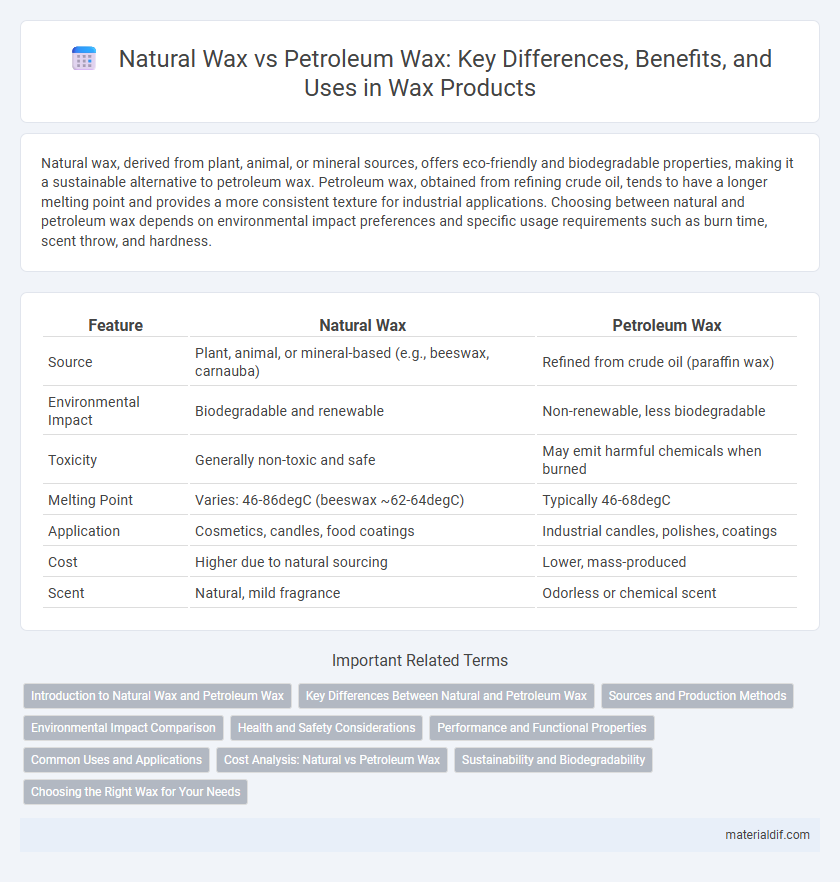Natural wax, derived from plant, animal, or mineral sources, offers eco-friendly and biodegradable properties, making it a sustainable alternative to petroleum wax. Petroleum wax, obtained from refining crude oil, tends to have a longer melting point and provides a more consistent texture for industrial applications. Choosing between natural and petroleum wax depends on environmental impact preferences and specific usage requirements such as burn time, scent throw, and hardness.
Table of Comparison
| Feature | Natural Wax | Petroleum Wax |
|---|---|---|
| Source | Plant, animal, or mineral-based (e.g., beeswax, carnauba) | Refined from crude oil (paraffin wax) |
| Environmental Impact | Biodegradable and renewable | Non-renewable, less biodegradable |
| Toxicity | Generally non-toxic and safe | May emit harmful chemicals when burned |
| Melting Point | Varies: 46-86degC (beeswax ~62-64degC) | Typically 46-68degC |
| Application | Cosmetics, candles, food coatings | Industrial candles, polishes, coatings |
| Cost | Higher due to natural sourcing | Lower, mass-produced |
| Scent | Natural, mild fragrance | Odorless or chemical scent |
Introduction to Natural Wax and Petroleum Wax
Natural wax, derived from plant and animal sources such as beeswax, carnauba, and candelilla, offers biodegradable and renewable properties ideal for eco-friendly products. Petroleum wax, including paraffin and microcrystalline wax, is a byproduct of crude oil refining, characterized by its versatility and affordability in industrial and consumer applications. Both wax types serve distinct roles based on their chemical composition, melting points, and sustainability factors.
Key Differences Between Natural and Petroleum Wax
Natural wax, derived from sources like beeswax, carnauba, and soy, is biodegradable, renewable, and contains fewer chemicals, making it environmentally friendly and non-toxic compared to petroleum wax. Petroleum wax, including paraffin, is a byproduct of crude oil refining, often less sustainable, with a longer burning time but potential environmental and health concerns due to its synthetic origin. Key differences include origin (renewable vs. fossil fuel), environmental impact (biodegradability vs. pollution), and chemical composition influencing burn quality and safety in applications like candle making and cosmetics.
Sources and Production Methods
Natural waxes, such as beeswax and carnauba wax, are derived from renewable biological sources including plants and animals, harvested through sustainable practices like beekeeping and palm leaf collection. Petroleum waxes, primarily paraffin and microcrystalline waxes, are extracted from crude oil through complex refining processes involving distillation and solvent dewaxing, relying on non-renewable fossil fuels. The production of natural wax emphasizes ecological balance and minimal chemical processing, whereas petroleum wax manufacturing depends on industrial-scale refining technologies with higher carbon footprints.
Environmental Impact Comparison
Natural wax, derived from plant or animal sources, offers superior biodegradability and less chemical pollution compared to petroleum wax, which is a byproduct of fossil fuel processing and contributes significantly to environmental degradation. The production of petroleum wax involves high energy consumption and releases greenhouse gases, exacerbating climate change and harming ecosystems. Choosing natural wax reduces reliance on non-renewable resources and minimizes contamination, making it a more sustainable option for environmentally conscious consumers.
Health and Safety Considerations
Natural waxes, such as beeswax and soy wax, are derived from renewable resources and contain fewer harmful chemicals, making them generally safer for indoor air quality and skin contact. Petroleum-based waxes, like paraffin, release potentially toxic compounds such as toluene and benzene when burned, posing respiratory health risks and contributing to indoor pollution. Choosing natural waxes reduces exposure to volatile organic compounds (VOCs) and promotes a healthier environment, especially for those with allergies or sensitivities.
Performance and Functional Properties
Natural wax, derived from plant and animal sources, offers superior biodegradability and better scent retention compared to petroleum wax, which is a synthetic byproduct of crude oil refining. Performance-wise, natural waxes typically have higher melting points and provide a cleaner, longer burn with less soot emission, enhancing overall functionality in candle making and cosmetics. Petroleum waxes, while more cost-effective and consistent in texture, tend to have lower melting points and may release harmful chemicals when burned, reducing their environmental and functional appeal.
Common Uses and Applications
Natural waxes, such as beeswax and soy wax, are frequently used in candles, cosmetics, and food packaging due to their biodegradability and non-toxic properties. Petroleum waxes, including paraffin wax, dominate industrial applications like sealing, waterproofing, and electrical insulation because of their cost-effectiveness and consistent texture. Both wax types serve essential roles in manufacturing, but natural waxes are favored for eco-friendly products while petroleum waxes excel in heavy-duty and commercial uses.
Cost Analysis: Natural vs Petroleum Wax
Natural wax, derived from beeswax or soy, typically incurs higher production costs due to limited availability and labor-intensive extraction processes, leading to elevated market prices. Petroleum wax, such as paraffin, benefits from large-scale refining and abundant raw materials, resulting in lower costs and widespread commercial use. Cost analysis favors petroleum wax for budget-sensitive applications, while natural wax is preferred for premium products emphasizing sustainability and eco-friendliness.
Sustainability and Biodegradability
Natural waxes, derived from plant and animal sources, offer superior sustainability and biodegradability compared to petroleum waxes, which are synthetic and rely on non-renewable fossil fuels. Natural waxes like beeswax, carnauba, and soy wax decompose more efficiently in the environment, reducing long-term pollution and carbon footprint. Petroleum waxes, such as paraffin, persist longer in ecosystems and contribute to environmental degradation due to their petrochemical origins and slower breakdown rates.
Choosing the Right Wax for Your Needs
Natural waxes, such as beeswax and soy wax, offer eco-friendly, biodegradable options with low toxicity and clean burning properties ideal for candles and cosmetics. Petroleum waxes like paraffin provide cost-effective, high-melting-point alternatives with excellent color and fragrance retention but rely on non-renewable fossil fuels. Selecting the right wax depends on factors including environmental impact, budget, intended use, and desired performance characteristics.
Natural Wax vs Petroleum Wax Infographic

 materialdif.com
materialdif.com